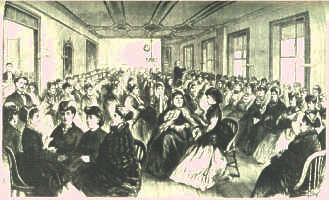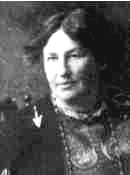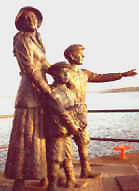
Employment bureau for domestic servants in New York
Up to the early 1800s, only one third of emigrants to the United States were female and many of those were wives and children leaving in family groups. During and after the Famine, women seem to have equalled men in numbers emigrating and the majority were single.
Domestic service was women's main option for employment. Accommodation and food were provided so they could save money and they were generally well treated. Coming from mud cabins, many girls found difficulty coping in the elegant houses of the well-off American people they worked for. The Irish maid, the 'Biddy' or 'Bridget' became a figure of amusement in America. She was stereotyped in print and cartoons as simple, innocent, lovably foolish and her accent and ignorance of American ways were often considered funny.
A study of letters suggests that female domestic servants were most generous in sending money home to Ireland.
|
In the case of Ireland annual remittances from America amounted on average to 5 million dollars between 1848 and 1900 and financed emigration of at least three-quarters of all those who went to the United States in that period. Much of that passage money came from women anxious to secure an independent livelihood for their female siblings and relatives ... |
| DEAR CATHERINE, YOU WILL let us Know what wages have you a year or how does that Country agree with you. As for our Country the potatoes all rot[t]ed this year in the ridges, and we are in a state of star[v]ing. Letter of Thomas Bourke, quoted by David Fitzpatrick in Cathal Póirtéir (ed), The great Irish famine, Cork, 1995, p.174. |

Employment bureau for domestic servants in New York
The Catholic Church in America increased its wealth also, due largely, it is said, to the donations of Irish women.
| In fact the histories of the Roman Catholic Church in Boston, New York, Philadelphia, Washington DC, Chicago and every city where the Irish settled indicate that women contributed the vast bulk of financial support for both parish maintenance and Catholic charitable work generally. Hasia Diner, Erin's daughters in America, Baltimore, 1983, p.137. |
Irish nuns set up foundations in America from 1812 and recruited other Irish women to join them there. Homeless Irish and other emigrants found sheltered accommodation in convents and the nuns found them jobs. Nuns also provided education for girls and Irish women moved up the social ladder faster than Irish men. Their daughters repeated this pattern and in 1910 more than a quarter of public school teachers in several American cities were daughters of Irish parents.
|
Charlotte Grace O'Brien, daughter of Young Irelander William Smith O'Brien was amongst those who lobbied for emigrants' rights in the later nineteenth century. Appalled by conditions in Cobh (then known as Queenstown), she founded a 105-bed lodging house there to shelter Irish women awaiting departure. She successfully drew attention also to conditions for women on board ship and in the tenements where they often stayed in America. |
 Charlotte Grace O'Brien |
It appears that Irish women were not prominent supporters of the women's suffrage movement in America and some joined movements opposed to women's suffrage. They seem to have been influenced by most Irish men, by the clergy and by the Irish-American press which was generally hostile to women's suffrage. The Fenian, John Boyle O'Reilly, editor of the Boston Pilot, declared in January 1871:
| Women's suffrage is an unjust, unreasonable, unspiritual abnormality ... It is a quack bolous to reduce masculinity even by the obliteration of femininity ... It is the sediment, not the wave of sex. It is the antithesis of that highest and sweetest mystery - conviction by submission and conquest by sacrifice. Quoted in Hasia Diner, Erin's daughters in America, Baltimore, 1983, p.145. |
|
Annie Moore (15) from Co. Cork was the first ever person to pass through the new immigration centre at Ellis Island, New York on 1 January 1892. Annie was coming on a steerage ticket with her two younger brothers Anthony and Philip to be reunited with their parents who had emigrated three years previously. To her surprise, she was greeted with flags, bunting and music, interviewed and questioned by several dignitaries and presented with a gold coin. She settled in the US, married and had a family there. She is commemorated by bronze statues both at Cobh and at Ellis Island. |
 Statue of Annie Moore and her brothers at Cobh Sculptor Jeanne Rynhart |
Probably about 200,000 Irish people have emigrated illegally to the US since the 1980s of whom many, including those with good education, work there at unskilled occupations.